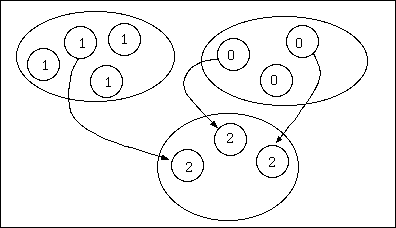HOME
UP
PREV
FURTHER NOTES
NEXT (Automated Stimulus Generation (Directed-Random Verification))
ABD - Sequential Logic Simplification
A finite-state machine may have more reachable states than it needs to perform its observable
function (n.b. one-hot coding does not increase the reachable state space).
 | A Moore machine can be simplified by the following procedure:
- 1. Partition all of the state space into blocks of
states where the observable outputs are the same
for all members of a block.
- 2. Repeat until nothing changes (i.e. until it closes)
For each input setting:
- 2a. Chose two blocks, B1 and B2.
- 2b. Split B1 into two blocks consisting of those
states with and without a transition from B2.
- 2c. Discard any empty blocks.
- 3. The final blocks are the new states.
Bisimulation algorithm not examinable in this course.
|
Alternative algorithm: start with one partition per state and repeatedly conglomerate.
The best algorithms use a mixture of the two approaches to meet in the middle.
»Wikipedia: Formal Equivalence Checking
Research example: CADP package: developed by the VASY team at INRIA.
Commercial products: Conformal by Cadence, Formality by Synopsys, SLEC by Calypto.
One future use of this sort of procedure might be to generate an instruction set
simulator for a processor from its full
RTL implementation. This sort of de-pipelining would give a non-cycle accurate,
higher-level model that runs much faster in simulation.
